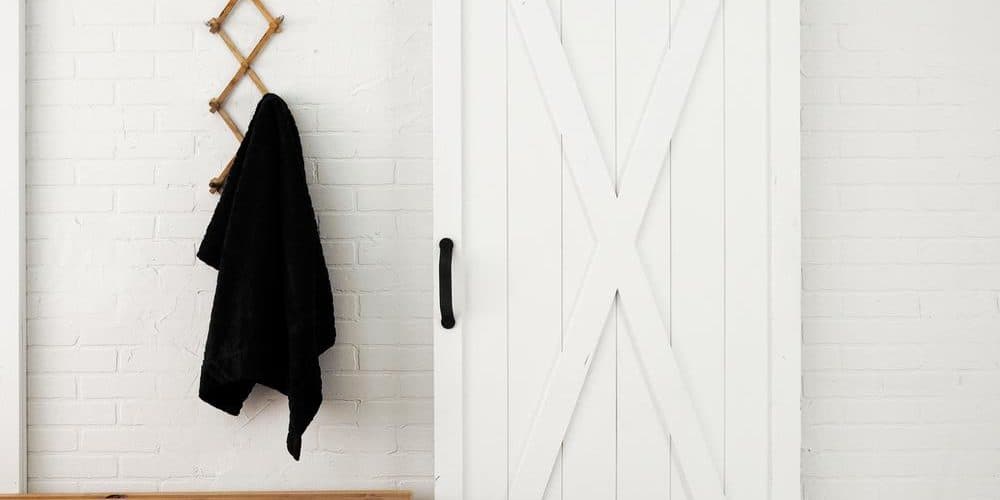Closets are such a functional part of room design that it is easy to think of a closet door as being rather ordinary. But just because closets are used to hide things, that doesn’t mean that the door should be treated the same way. Function and great looks can coexist, and many choices are available.
Contents
Wooden Closet Doors
Nothing makes a better “wood look” than the real thing. Varnished or waxed wood reflects light from a depth that is hard to duplicate in other materials. Wooden closet doors come in three basic styles.
Flat or Slab
Flat closet doors often use hollow core construction to reduce weight and cost. They can enhance the contemporary, minimalist, or Scandinavian flavor of a room. They are also an excellent choice when turning a plain closet door into a mural or bulletin board surface, and they provide a stable backing for hanging mirrors.
Paneled
Enclosing closets with traditional wood paneled doors can unify a home’s design by matching the panel styles used elsewhere for room or hallway entry. The higher quality doors are designed with floating panel construction to allow for swelling or contraction of the wood as temperature and humidity levels fluctuate. This greatly reduces the potential for warping.
Louvered
Louvered closet doors are popular because they allow some natural ventilation and blend well with a plethora of architectural styles such as American country, British colonial, Old World continental, retro, Georgian, or South Sea tropical. The louvers may be fixed, operable, of faux, depending upon the need. Solid wood fixed-louver doors are widely available from home centers, lumberyards and builder’s supply stores in standard sizes that fit most closets. Custom doors are easily ordered if the customer desires more choice in wood species, stile and rail sizes, louver thickness, or the amount of air flow. Louvers are sometimes combined with flat, raised, or grooved panels or to create a door that allows ventilation on the top half but has a solid bottom panel.
Molded Closet Doors
Molded closet doors are made of fiberboard and may have either a flat or wood textured surface. Most often the styles mimic the panels or louvers of wooden doors. Molded doors come pre-primed and ready to paint. They resist warping and are easy to clean, which are important considerations for a high-use closet. Molded doors are manufactured and rated for different levels of fire resistance that can affect the cost of the door. Some styles may offer a sound deadening inner core, but this feature is not usually necessary for a closet and is one place the consumer may economize without any loss of function.
Fabric Closet Doors
Fabrics can be hung as curtains over a closet. They can also be stretched over a frame which can be hinged or hung as a closet door. Fabric is an inexpensive and easily changed material for screening a closet.
Accordion doors
Vinyl folding doors make thrifty closet doors. They take up very little space and are easy to install. Wooden folding doors are often custom made and can be a good option for office closets that house bulky supplies or a wet bar.
Hanging methods
Hinged Doors
A single door may be hinged on one side only, a set of panels can open from the center like French doors, or a series of four may be joined as bifold doors. Bifold doors fold outward into a room and are popular for closets because they allow a wide opening without using up room space.
Sliding doors are hung from an overhead track. In a standard installation, one-half of the closet is open at a time because the doors overlap and stack behind one another when open. If wall space permits, sliding doors are sometimes decorated or mirrored and slide over the wall of the room to give full access to the closet.
A pocket door slides into the wall adjacent to the closet. These doors are useful in closet openings where the space is at premium or where a conventional door would obstruct free access. They work best in relatively small openings. Adding a pocket after the initial construction is a major remodeling project.
Cost comparisons—installation hardware is not included
A 28″ fiberboard hollow core flat door retails for about $20.
A 28″ fiberboard bifold door sells for about $35.
A 28″ vinyl accordion door begins at about $25.
A 28″ wooden louvered bifold starts at $130.
Sliding door panels for a 4-foot opening begin at about $80.
Installation
Most premade closet doors come with installation instructions for do-it-yourselfers. Many retailers that sell closet doors have lists of recommended installers available. Costs vary in different regions of the country.
Related Posts



